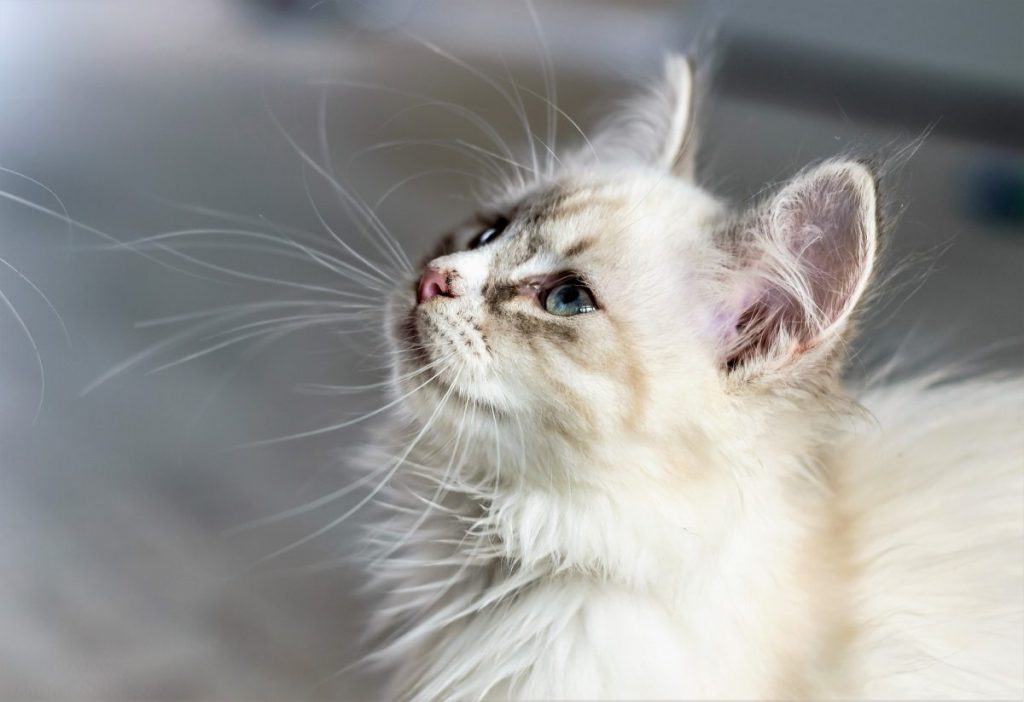For anyone who owns a pet, being aware of certain types of diseases is crucial to maintaining their quality of life in the event that they’re sick. Lymphoma is a type of cancer frequently diagnosed in cats, however lymphoma in dogs is also quite common as well.. Invading the blood cells, it is a cancer that originates in the lymphocyte cells, which play a vital part in the body’s immune system.
Because they comprise the majority of the cells found in the lymph nodes, they are integral to your cat’s natural defenses against disease. This article will explore the causes, signs, and types of treatment for feline lymphoma so that you can provide the best care for your beloved cat in the instance he or she is ill.
What Is Lymphoma?
A network of nodes and vessels that are capable of transporting disease organisms and foreign proteins, the lymph system is found in blood and tissues throughout your cat’s body. Consequently, they perform an important role in the immune system, such as manufacturing antibodies and other biological substances that stave off disease and infection.
In the instance of lymphoma, the cancer cells attack and destroy normal healthy tissues throughout the body. Although lymphoma can manifest itself anywhere in your cat’s body, certain sites (such as the lymph nodes, GI tract and mediastinum) are more frequently affected by the disease than others.
Additionally, there are two forms of lymphocytes: B and T cells; lymphoma may involve abnormal or malignant cell growth that occurs primarily in the lymph nodes, bone marrow, and visceral organs (such as the heart, lungs, liver, pancreas or intestines). Responsible for nearly 90% of blood cancers in cats, lymphoma is also accountable for roughly 33% of feline tumors, as well as the most frequent cause for hypercalcemia.
As lymphoma progresses, the disease can affect other organs within the body. Signs may include chronic fatigue/lethargy, vomiting and diarrhea, and a decrease in appetite. However, due to the different types of feline lymphoma and anatomical site of the disease, physical symptoms may vary. Below, a list of commonly-diagnosed forms of feline lymphoma along with corresponding symptoms:

Types of Feline Lymphoma
Alimentary form (occurring in the gastrointestinal tract, liver, abdomen and surrounding lymph nodes). The most common form of feline lymphoma, this disease usually occurs in cats between the ages of 9-13 years of age and is the least likely to be linked to feline leukemia. Symptoms of this form of feline lymphoma include:
- Black or tarry bowel movements
- Blood in stool
- Constipation
- Diarrhea
- Extreme fatigue or lethargy
- Signs of anorexia
- Vomiting
Mediastinal form (occurring in the spaces between the pleural sacs/lungs). Commonly associated with feline leukemia, this form of lymphoma is found in the chest cavity and affects the thymus and affiliated lymph nodes. Signs of this form of feline lymphoma include:
- Excessive coughing
- Loss of appetite
- Noticeable weight loss/anorexia
- Open-mouth breathing
Multicentric form (occurring in the lymph nodes). Typically affecting multiple lymph nodes/organs, this form of the disease is most frequently associated with feline leukemia; therefore, prognosis isn’t as good if the cat has already been tested FeLV positive). Signs and symptoms of this form of lymphoma in cats include:
- Depression/extreme lethargy
- Marked weight loss
- Noticeable loss of appetite
- Swollen lymph nodes (such as under the arms, in jaw or in groin region)
Renal Form (occurring in the kidneys). This form of feline lymphoma is characterized by:
- Anorexia
- Increased urination and thirst
- Signs of weakness
- Vomiting and/or other digestive disorders
Solitary form (may occur in any anatomical location):
- Symptoms depend upon physical location of the disease
Causes of Lymphoma in Cats
According to experts, the occurrence of feline lymphoma is primarily linked to exposure to the feline leukemia virus (FeLV) and the feline immunodeficiency virus (FIV, or feline AIDS). Studies have shown that cats who have been infected with either of these viruses have a much greater rate of lymphomas than the general feline population.
Diagnosis of Feline Lymphoma
Due to the wide nature of symptoms that may be indicative of other diseases or underlying health issues, it is imperative that your veterinarian run a thorough battery of tests to rule other causes and factors out before arriving at a lymphoma diagnosis. Once you’ve scheduled a visit to the vet, he or she will ask for a complete history of your cat’s health, as well as symptoms your pet has displayed.
Providing detailed information to your pet’s physician can help to determine the type of lymphoma as well as what organs are being affected. A physical exam may reveal swellings in the gastrointestinal tract (GI) or lymph nodes. In addition to a comprehensive physical examination, your vet may run a variety of different laboratory tests, including a urinalysis, diagnostic imaging (to screen for tumors or swellings in internal organs), blood count (CBC) and a biochemistry profile (to determine organ involvement), among others.
Additionally, your vet may perform a fine needle aspiration or biopsies to properly diagnose the presence of lymphoma-related disease. In certain instances, he or she may also recommend surgery to further confirm findings, as well as initial treatment for the disease.
Treatment & Prognosis of Feline Lymphoma
As we have already outlined, there are several primary types of feline lymphoma; in every form, the tumors are the result of abnormal cell proliferation within your cat’s lymphoid tissues. Due to the nature of lymphocytes being present throughout the body, the disease may occur nearly anywhere and affect many different organs.
The site of the disease therefore determines the symptoms, treatment, and prognosis, as the initial location of the malignant cellular growth is frequently linked to the root cause.
Lymphoma is also categorized by the type of cells it affects; generally speaking, there are two major types of lymphoma:
- Low grade (or small cell) lymphoma
- High grade (or large cell) lymphoma
Because these two types of lymphoma display different characteristics, a definitive diagnosis is required to assess an appropriate form of treatment.
High Grade Lymphoma in Cats
In the instance of high grade lymphoma, treatment therapies typically consist of chemotherapy as determined by your veterinarian. Your vet will closely monitor your cat’s progress to check his white and red blood cell numbers, along with mass or tumor formation, which may require surgery or other types of radiation treatments.
As in any case of chemo, the primary goal is to kill the majority of the cancer cells so your cat is in a state of remission – meaning that all primary symptoms of cancer have temporarily gone away. In the case of successful remission, your cat won’t display signs of cancer (masses and lumps will disappear), and he will eat, drink and behave the way he did before he developed cancer.
Although total remission is reported within 50 to 75% of cats, owners have noted that even partial remission results in a better overall quality of life for their pets. Feline survival rates are reported at an average of 6 to 9 months, but the length of remission is dependent on a few key factors, including:
- The main anatomical site of the cancer
- How sick your cat is at the onset of treatment
- The presence of feline leukemia: cats that are FeLV or FIV-positive have a lower rate of response to therapy, as well as a shorter average survival rate when treated.
- How promptly the tumor is diagnosed and treated
- The extent of disease
It is important to keep in mind that these numbers and statistics represent average values, as each cat is an individual and will respond to treatment differently.
Low Grade Lymphoma in Cats
In the case of low grade (small cell) lymphoma, this type of cancer usually occurs in the GI (gastrointestinal) tract of felines. Unlike high grade lymphoma, it grows more slowly and therefore, different forms of chemotherapy are required.
Statistics have shown that 85-90% of cats have responded positively to treatment, although response time and effectiveness varies among individual animals. Survival rates for cats who receive treatment average 1.5-2 years.
Low Grade & High Grade Feline Lymphoma: Side Effects of Treatment
The side-effects of chemotherapy for your cat is dependent on a number of factors (such as how aggressive your cat’s cancer is, how sick he is at the onset of treatment, and organ function abnormalities).
Your vet will be able to prescribe the most effective course of therapy based on these factors, keeping in mind his quality of life while monitoring his progress and reaction to his treatments. On a positive note, it may also be worth mentioning that the negative side-effects that humans undergo as a result of chemo are less severe and less common for animals receiving the same treatments.
Although there isn’t a guaranteed cure or single treatment available to treat various feline lymphomas, the ultimate goal is to improve your cat’s quality of life and make him as comfortable as possible. As we have discussed, there are a number of treatments available, including chemotherapy and radiotherapy.
Upon meeting with your vet, he or she will be able to determine if your cat is a feasible candidate for such treatments. In addition, you may wish to discuss homeopathic treatments to support your cat’s overall well-being and sense of comfort, including natural pet supplements and a healthy diet regiment.
Looking Ahead: Living and Management of Feline Cancer
Pet owners want the very best for their beloved fur-babies. With that said, monitoring your cat’s progress carefully throughout his determined course of lymphoma treatment is essential to ensuring his overall well-being and level of comfort. Observing your pet’s food and water consumption is critical during his recovery phase.
In addition, be sure to check for infections, as your cat’s white blood cell production and immune system will be compromised, therefore making him more prone to infections. Symptoms of infection may include vomiting/diarrhea, loss of appetite, a decrease in activity, depression, and lethargy.
If you notice these signs or other indications of illness during rounds of chemotherapy treatment, be sure to contact your vet immediately. Although these signs may be a brief or temporary reaction to the medications being used during therapy, rapid treatment can help to prevent serious secondary side-effects from occurring.
If you choose to administer chemotherapy to your cat after your vet has determined a feasible course of treatment, you will be required to take your cat in for routine evaluations. During visits, you can anticipate blood testing, physical examinations, and other tests to gauge how well your cat is responding to treatment, as well as determining what adjustments need to be made.
Additionally, if your veterinarian has prescribed any type of medications to be administered at home, be sure to take note of your cat’s response and report back to your vet; you may also wish to prepare a list of questions to ask during your visit. Establishing a clear course of treatment as a pet owner is vital to providing proper care for your cat during his therapy, as well as following your vet’s instructions implicitly.
As in the case of any medication, never give your cat any form of drug without your vet’s consent, and be sure to adhere to instructions carefully to avoid overdosing. In addition, be certain to let other family members and caregivers know your cat’s medication schedule and dosages.

A Moral Decision: Is Cancer Therapy the Right Course of Treatment for My Cat?
Although the survival rates and therapy results may vary between animals, the most difficult decision for many pet owners lies within the moral decision of cancer therapy – if you feel secure in your decision that this is the best choice for your pet, you may be able to prolong your cat’s life by months or even years.
In the end, there are no right or wrong solution, just a desire to provide your cat with the best and most humane options possible based on your cat’s unique prognosis. Discuss the possible forms of treatment carefully with your vet, as well as weighing the pros and cons of cancer treatment (such as the financial costs, your personal belief systems, or the logistics entailed).
Ultimately, your cat’s well-being and comfort will play an integral role in your decision when determining your pet’s course of treatment.
Here at Canna-Pet we have a wealth of experience creating CBD products for pets. CBD can be potentially beneficial for your pet’s health and wellness. Be sure to check out our CBD for cats and our other CBD pet products!
Sources:
- “Select a Stage on the Timeline to View More Content. Lymphoma in Cats.” PetMD, Accessed 18 May 2017. www.petmd.com/cat/conditions/cancer/c_ct_lymphoma.
- “Feline Lymphoma.” IVG Hospitals, Accessed 18 May 2017. www.ivghospitals.com/service/oncology/feline-lymphoma/.
- Barchas, Eric. “Ask a Vet: What Is Lymphoma in Cats? Can It Be Treated?” Catster, 30 Aug. 2017, Accessed 18 May 2017. www.catster.com/lifestyle/cat-health-tips-feline-lymphoma-treatment-ask-a-vet.
- “Lymphoma in Cats – Symptoms, Causes, Diagnosis, Treatment, Recovery, Management, Cost.” WagWalking, 12 Oct. 2016, Accessed 18 May 2017. www.wagwalking.com/cat/condition/lymphoma.
- Eckstein, Sandy. “Cancer in Cats: Types, Symptoms, Prevention, and Treatment.” WebMD, Accessed 18 May 2017. www.pets.webmd.com/cats/guide/cancer-in-cats-types-symptoms-prevention-and-treatment#1.








